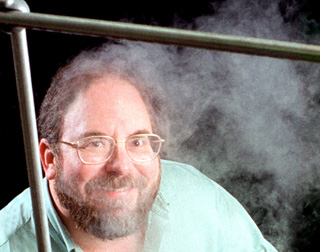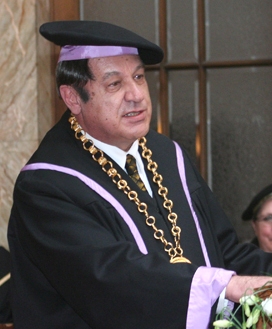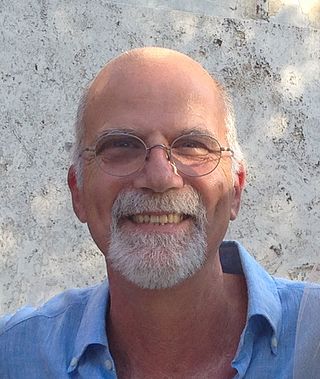Combinatorial chemistry comprises chemical synthetic methods that make it possible to prepare a large number of compounds in a single process. These compound libraries can be made as mixtures, sets of individual compounds or chemical structures generated by computer software. Combinatorial chemistry can be used for the synthesis of small molecules and for peptides.

In chemistry, a foldamer is a discrete chain molecule (oligomer) that folds into a conformationally ordered state in solution. They are artificial molecules that mimic the ability of proteins, nucleic acids, and polysaccharides to fold into well-defined conformations, such as α-helices and β-sheets. The structure of a foldamer is stabilized by noncovalent interactions between nonadjacent monomers. Foldamers are studied with the main goal of designing large molecules with predictable structures. The study of foldamers is related to the themes of molecular self-assembly, molecular recognition, and host–guest chemistry.

Ceragenins, or cationic steroid antimicrobials (CSAs), are synthetically-produced, small-molecule chemical compounds consisting of a sterol backbone with amino acids and other chemical groups attached to them. These compounds have a net positive charge that is electrostatically attracted to the negative-charged cell membranes of certain viruses, fungi and bacteria. CSAs have a high binding affinity for such membranes and are able to rapidly disrupt the target membranes leading to rapid cell death. While CSAs have a mechanism of action that is also seen in antimicrobial peptides, which form part of the body's innate immune system, they avoid many of the difficulties associated with their use as medicines.

Christopher Abell was a British biological chemist. He was Professor of Biological Chemistry at the Department of Chemistry of the University of Cambridge and Todd-Hamied Fellow of Christ's College, Cambridge. On his 2016 election to the Royal Society, the society described his research as having "changed the face of drug discovery."

Julius Rebek Jr. is a Hungarian-American chemist and expert on molecular self-assembly.

Ronald T. Raines is an American chemical biologist. He is the Roger and Georges Firmenich Professor of Natural Products Chemistry at the Massachusetts Institute of Technology. He is known for using ideas and methods of physical organic chemistry to solve important problems in biology.
Ayyalusamy Ramamoorthy is the Robert W. Parry Collegiate Professor of Chemistry and Biophysics at the University of Michigan, Ann Arbor. In 2018, he was elected as a fellow of the Royal Society of Chemistry.

Kenneth S. Suslick is the Marvin T. Schmidt Professor of Chemistry Emeritus at the University of Illinois at Urbana–Champaign. His area of focus is on the chemical and physical effects of ultrasound, sonochemistry, and sonoluminescence. In addition, he has worked in the fields of artificial and machine olfaction, electronic nose technology, chemical sensor arrays, and the use of colorimetric sensor arrays as an optoelectronic nose.

Klaus H. Hofmann was an American biological chemist and medical researcher. The New York Times called Hofmann an "expert on synthesis of body compounds". His career was highlighted by synthesis of a prototype birth control pill, isolation and structural characterization of biotin, determination of the lysine specificity of the pancreatic protease trypsin, the first chemical synthesis of a fully biologically-active portion of the peptide hormone, and structure-function studies on ribonuclease (RNase).

Ayyappanpillai Ajayaghosh is a research scientist/academician in the domain of interdisciplinary chemistry, and the former Director of the National Institute for Interdisciplinary Science and Technology. He is known for his studies on supramolecular assemblies, organogels, photoresponsive materials, chemosensory and security materials systems and is an elected fellow of all the three major Indian science academies viz. the National Academy of Sciences, India, Indian National Science Academy and the Indian Academy of Sciences as well as The World Academy of Sciences. The Council of Scientific and Industrial Research, the apex agency of the Government of India for scientific research, awarded him the Shanti Swarup Bhatnagar Prize for Science and Technology, one of the highest Indian science awards for his contributions to Chemical Sciences in 2007. He is the first chemist to receive the Infosys Science Prize for physical sciences, awarded by the Infosys Science Foundation. He received the TWAS Prize of The World Academy of Sciences in 2013 and the Goyal prize in 2019.

Bernd Michael Rode was an Austrian professor of chemistry at the University of Innsbruck and founder of the Austrian-South-East-Asian Academic University Network (ASEA-UNINET). Prof. Rode retired in 2011 but remained actively involved in teaching and research as well as in the thesis supervision.

Dennis P. Curran is an American organic chemist and a professor of chemistry at University of Pittsburgh known for his research in the fields of organic chemistry, radical chemistry, and fluorous chemistry.

Maurizio Prato, is an Italian Organic Chemist, who is best known for his work on the functionalization of carbon nanostructures, including fullerenes, carbon nanotubes and graphene. He developed a series of organic reactions that make these materials more biocompatible, less or even non toxic, amenable to further functionalization, and easier to manipulate. He is Professor of Organic Chemistry at the University of Trieste and Research Professor at CIC BiomaGUNE in San Sebastián, Spain.
Usha Ranjan Ghatak (1931–2005) was an Indian synthetic organic chemist, stereochemist and the director of the Indian Association for the Cultivation of Science (IACS). He was known for his contributions in developing novel protocols of stereoselective synthesis of diterpenoids. He was an elected fellow of the Indian Academy of Sciences and the Indian National Science Academy. The Council of Scientific and Industrial Research, the apex agency of the Government of India for scientific research, awarded him the Shanti Swarup Bhatnagar Prize for Science and Technology, one of the highest Indian science awards, in 1974, for his contributions to chemical sciences.
Sandeep Verma is an Indian bioorganic chemist and chemical biologist, and a Professor in the Department of Chemistry at the Indian Institute of Technology, Kanpur (IITK). At IITK, he heads Sandeep Verma's Research Group in the areas of ordered peptide assemblies, metal-mediated nanoscale systems, programmable soft matter for neuronal regeneration, novel antimicrobials, and small molecule-stem cell modulation. He is an elected fellow of the Indian National Science Academy (INSA), the Indian Academy of Sciences, the National Academy of Sciences, India., and the Indian National Academy of Engineering. The Council of Scientific and Industrial Research, the apex agency of the Government of India for scientific research, awarded him the Shanti Swarup Bhatnagar Prize for Science and Technology, one of the highest Indian science awards, in 2010, for his contributions to Chemical Sciences.
Suresh Kumar Bhatia is an Indian-born chemical engineer and a professor at the School of Chemical Engineering, University of Queensland. He is known for his studies on porous media and catalytic and non-catalytic solid fluid reactions. He was awarded an ARC Australian Professorial Fellowship (2010–15) and is an elected fellow of the Indian Academy of Sciences (1993), and the Australian Academy of Technological Sciences and Engineering (2010). In 1993, the Council of Scientific and Industrial Research, the Indian government's peak agency for scientific research, awarded him the Shanti Swarup Bhatnagar Prize for Science and Technology, one of the highest Indian science awards, for his contributions to the engineering sciences.

Nediljko "Ned" Budisa is a Croatian biochemist, professor and holder of the Tier 1 Canada Research Chair (CRC) for chemical synthetic biology at the University of Manitoba. As pioneer in the areas of genetic code engineering and chemical synthetic biology (Xenobiology), his research has a wide range of applications in biotechnology and engineering biology in general. Being highly interdisciplinary, it includes bioorganic and medical chemistry, structural biology, biophysics and molecular biotechnology as well as metabolic and biomaterial engineering. He is the author of the only textbook in his research field: “Engineering the genetic code: expanding the amino acid repertoire for the design of novel proteins”.
Bradley Lether Pentelute is currently a professor of chemistry at the Massachusetts Institute of Technology (MIT). His research program lies at the intersection of chemistry and biology and develops bioconjugation strategies, cytosolic delivery platforms, and rapid flow synthesis technologies to optimize the production, achieve site-specific modification, enhance stability, and modulate function of a variety of bioactive agents. His laboratory successfully modified proteins via cysteine-containing “pi-clamps” made up of a short sequence of amino acids, and delivered large biomolecules, such as various proteins and drugs, into cells via the anthrax delivery vehicle. Pentelute has also made several key contributions to automated synthesis technologies in flow. These advances includes the invention of the world's fastest polypeptide synthesizer. This system is able to form amide bonds at a more efficient rate than standard commercial equipment and has helped in the process of understanding protein folding and its mechanisms. This automated flow technology was recently used to achieve total chemical synthesis of protein chains up to 164 amino acids in length that retained the structure and function of native variants obtained by recombinant expression. The primary goal of his endeavor is to use these processes to create designer biologics that can be used to treat diseases and solve the manufacturing problem for on-demand personalized therapies, such as cancer vaccines.
Milan Mrksich is an American chemist. He is the Henry Wade Rogers Professor of biomedical engineering at Northwestern University and has additional appointments in chemistry and cell and developmental biology. He also serves as both the founding director of the Center for Synthetic Biology and as an associate director of the Robert H. Lurie Comprehensive Cancer Center at Northwestern. Mrksich also serves as the Vice President for Research of Northwestern University.
Amy M. Barrios is an American medicinal chemist working as a professor of Medicinal Chemistry and the Associate Dean for Postdoctoral Affairs for the University of Utah. Barrios’ research lab focuses on developing probes to study protein tyrosine phosphatase (PTP) activity and regulation.











